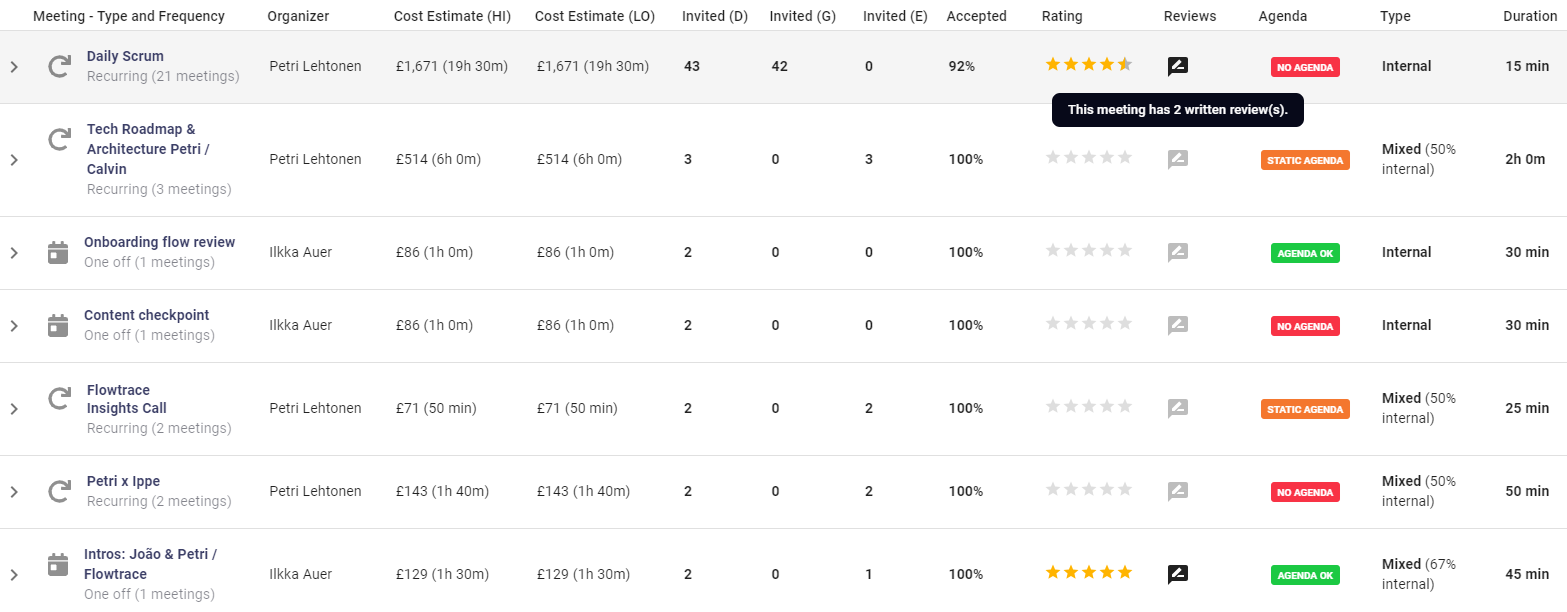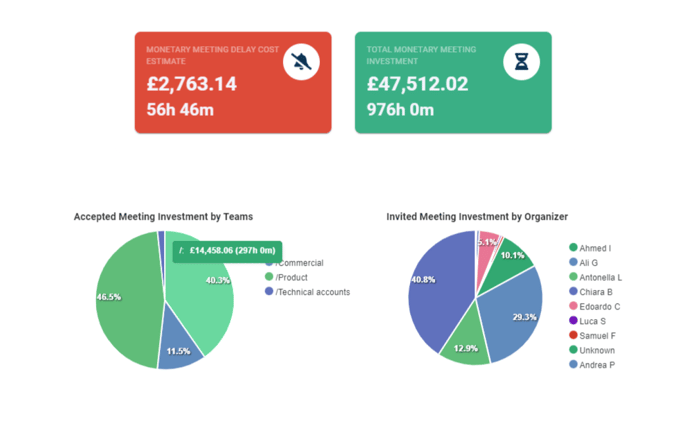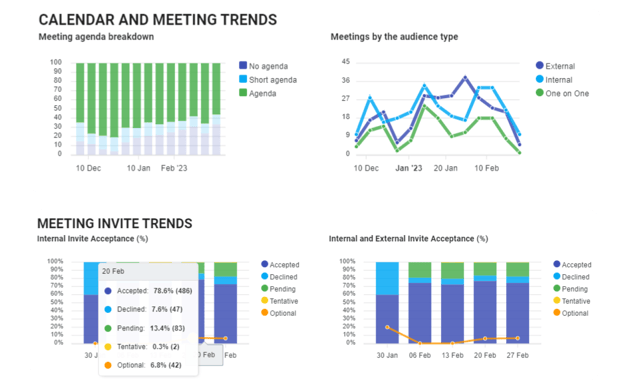Calendar Analytics For Outlook
Improve time management & meeting organization with calendar analytics for Outlook. Get insights into meeting culture, enhancing productivity &...
Meeting analytics for Outlook can revolutionize how your company conducts meetings. Flowtrace provides advanced meeting analytics to enhance productivity.
Meeting efficiency is more than scheduling and agenda-setting, it involves a deeper understanding of various metrics and patterns that dictate how these meetings impact organizational productivity and costs. Understanding and utilizing meeting analytics can offer a data-driven view to evaluate and enhance the effectiveness of meetings.
As some businesses struggle with the challenges of time management and resource allocation, the role of meeting analytics has grown increasingly vital in recent years. Flowtrace is the established solution to this, providing advanced meeting analytics that expand upon and interpret the dynamics of meetings for managers to act upon.
This article will look at meeting analytics for Outlook, exploring the benefits, utilization, and how this data can revolutionize the way managers conduct and benefit from their meetings.

Meeting analytics involve the systematic collection, analysis, and interpretation of data associated with meetings. This includes evaluating factors such as meeting duration, frequency, participant engagement, and decision-making effectiveness.
By quantifying these elements, meeting analytics transform abstract meeting activities into concrete, actionable data, offering crucial insights for enhancing meeting productivity and effectiveness.
The significance of meeting analytics in business cannot be overstated. In a study by Atlassian, it was found that the average office worker spends over 31 hours each month in unproductive meetings.
Additionally, the Harvard Business Review reported that 50% of meeting time is essentially wasted, equating to four work days each month per employee.
Also, the same source cites that 71% of senior managers believe meetings are unproductive and inefficient, highlighting a widespread sentiment among leadership regarding the ineffectiveness of current meeting practices.
These startling statistics highlight the issue of inefficient meetings plaguing today's workplaces.
Flowtrace's approach to meeting analytics, particularly when integrated with tools like Microsoft Outlook, offers a solution to these inefficiencies. By providing detailed insights into various meeting metrics, we help you understand and improve how meetings are conducted, ensuring they are a valuable use of time and resources.
This integration not only enhances the capacity to track and analyze meetings but also empowers teams to make data-driven decisions for optimizing meeting schedules and content, ultimately leading to more productive and meaningful meetings.
Meeting analytics are essential and by providing a detailed analysis of meeting patterns, these analytics contribute significantly to business efficiency and productivity. They enable managers to identify and address common meeting challenges, such as excessive duration, poor attendance, or lack of clear objectives. With insights from meeting analytics, companies can streamline their meetings, ensuring they are concise, focused, and productive.
Also, meeting analytics impact decision-making processes. They offer leaders a data-driven approach to assess the effectiveness of meetings, enabling them to make informed decisions about meeting frequency, format, and participants. This leads to more strategic and purposeful meetings, where time is used judiciously, and discussions are more likely to yield productive outcomes.

Flowtrace takes meeting analytics to the next level. The dashboard provides a comprehensive view of meeting culture, encompassing various aspects such as meeting frequency, duration, participant engagement, and overall effectiveness. This comprehensive approach ensures that no aspect of meeting dynamics is overlooked. Unique features include:
Integration with Existing Tools: Flowtrace seamlessly integrates with popular workplace tools like Microsoft Outlook, and Google Calendar, allowing for a unified and streamlined analytics experience. This integration ensures that analytics are easily accessible and actionable within the existing workflow.
AI-Powered Insights: Leveraging artificial intelligence, Flowtrace delivers deep insights and recommendations, enabling organizations to continuously improve their meeting practices. These insights are tailored to the specific needs and patterns of each organization, ensuring relevance and applicability.
Real-Time Analytics: Flowtrace provides real-time analytics, allowing immediate visibility into meeting patterns and enabling swift action to enhance meeting effectiveness.
Filterable Dashboards: Users can tailor their analytics dashboard to focus on the metrics most relevant to their needs, making it easier to track progress and identify trends.
Employee Engagement and Feedback: Flowtrace encourages employee participation in the analytics process, offering tools for feedback and engagement. This feature ensures that improvements in meeting culture are aligned with the needs and perceptions of the entire team.

Flowtrace’s integration with Microsoft Outlook is a key solution for organizations looking to improve meeting performance and reduce meeting costs. This integration is smooth and intuitive, allowing users to merge the powerful analytics of Flowtrace with the functions of Outlook. Once integrated, Flowtrace can display real-time cost estimates associated with scheduling meetings.
Meeting costs can be combined with detailed meeting analytics from the Flowtrace dashboard, enabling leaders to make data-driven decisions. This integration ensures that all meeting-related data, such as frequency, duration, participant engagement, feedback, and costs, are offered in a unified platform for meeting management and analysis.
You cannot track analytics in Outlook directly, but there are different methods to do so. Outlook analytics via Power BI, as a separate platform, offers basic capabilities for tracking meeting metrics such as scheduling, attendee responses, and calendar availability. However, its native features are primarily focused on meeting organization and scheduling, with limited scope for in-depth analytics.

Flowtrace's Meeting Cost Calculator adds a new focus on meeting analytics within Outlook. This tool provides a detailed breakdown of the financial impact of meetings, transforming the way managers perceive and balance their meeting time.
The calculator operates by analyzing various factors such as the duration of meetings, the number of attendees, and their respective roles or salary levels. By integrating these factors, it accurately computes the total cost of each meeting.
The Outlook cost calculator by Flowtrace integrates directly with the calendar, displaying the cost implications of meetings in real time. This feature brings a new level of awareness to meeting planning and scheduling. Managers and team members can see the financial impact of meetings right alongside their regular calendar entries, making it easier to weigh the cost against the anticipated value of the meeting.
Managers play an essential role in an organization's meeting culture, and with tools like Flowtrace, they can leverage analytics to drive team productivity. One key strategy is to use data to identify patterns and trends in meeting practices. Managers can analyze metrics such as meeting duration, frequency, attendance, and participant engagement to gain insights into how meetings are currently being conducted.
Using this data, managers can pinpoint inefficiencies, such as meetings that consistently run over time or have low engagement levels. They can then take targeted actions to address these issues, such as implementing stricter time limits, refining meeting agendas, or revising the participant list to ensure meetings are more focused and productive.
Flowtrace's analytics enable managers to monitor the effectiveness of changes over time. By continually reviewing meeting data, they can assess the impact of their interventions and make further adjustments as needed. This iterative process ensures that meeting practices are constantly evolving to meet the changing needs of the team and the organization.
.png?width=680&height=382&name=Outlook%20Add%20In%20Store%20Images%20-%202%20(1).png)
Getting the meeting analytics for Outlook is a simple process and allows users to leverage the full potential of Flowtrace's meeting analytics. Here’s a guide to get started:
Integration Setup: Flowtrace will be set up with your Outlook account. This is typically done through a simple add-in installation process, which links Flowtrace to your Outlook calendar and email.
Data Synchronization: Once integrated, Flowtrace begins to synchronize with your Outlook data, pulling information from your meetings and emails to start the analytics process.
Accessing Analytics: To view your analytics, navigate to the Flowtrace dashboard within Outlook. The dashboard is designed to be intuitive and user-friendly, providing a clear view of your meeting analytics.
Meeting Cost Calculator: This is an extra setting that comes from adding an extension to Microsoft Outlook™. It will be seen in real-time within your Outlook calendar, showing information on how much each meeting will cost.
Implementing and effectively using meeting analytics comes with its set of challenges. Common issues include resistance to change, data overload, and integration complexities. However, Flowtrace adeptly addresses these challenges within the Outlook environment:
Resistance to Change: Employees and managers may be hesitant to adopt new tools or change established meeting practices. Flowtrace counters this by offering an intuitive and easy-to-use interface within the familiar Outlook environment, making the transition smoother.
Data Overload: The influx of data from analytics can be overwhelming. Flowtrace simplifies this by presenting data in an organized, easy-to-digest format, with actionable insights clearly highlighted.
Integration Complexities: Integrating a new tool with existing systems can be daunting. Flowtrace’s seamless integration with Outlook ensures a hassle-free setup, allowing organizations to start benefiting from analytics without technical difficulties.
Meeting analytics are expected to evolve, becoming more sophisticated and integral to business operations. Predictions and trends include:
Flowtrace is set to be a key player, continually adapting and enhancing its platform to meet the changing demands of meeting management.
Flowtrace’s meeting analytics for Outlook represent a significant leap forward in meeting management. By offering detailed insights into meeting dynamics and costs, Flowtrace transforms how organizations approach their meetings, turning them into more productive, efficient, and cost-effective engagements.
Improve time management & meeting organization with calendar analytics for Outlook. Get insights into meeting culture, enhancing productivity &...
Transform your organization with data-driven meeting cultures. Learn how to optimize meetings, increase productivity, and drive better business...
Optimize meetings with Flowtrace Meeting Analytics to address common pain points, enhance efficiency, and drive team engagement. Learn how to improve...